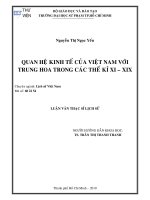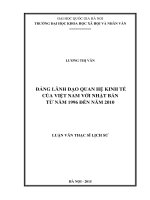Quản trị kinh doanh luôn là một trong những ngành hấp dẫn các bạn trẻ năng động, đặc biệt trong xu thế hội nhập kinh tế Quốc tế của Việt Nam những năm gần đây. Việc tìm hiểu rõ về ngành Quản trị kinh doanh giúp bạn định hướng nghề nghiệp tốt hơn trước kh
Bạn đang xem bản rút gọn của tài liệu. Xem và tải ngay bản đầy đủ của tài liệu tại đây (857.85 KB, 11 trang )
Chapter 12
Leadership Power and Influence
1
Chapter Objectives
Recognize your natural leadership frame of
reference and how you can expand your
perspective.
Use power and politics to help accomplish
important organizational goals.
Identify types and sources of power in
organizations and know how to increase power
through political activity.
Use the influence tactics of rational persuasion,
friendliness, reciprocity, developing allies, direct
appeal, and scarcity.
2
4. Symbolic
Ex. 12.1 Four
Leader Frames
of Reference
3. Political
Mind-set: Sees
organization as
2. Human
jungle, power,
Resource
schemes
Mind-set: Sees
Emphasis:
organization as
Resource
family, belonging,
allocation,
clan
negotiation,
1. Structural Emphasis:
coalition building
People, support,
Mind-set: Sees
Dangers: Power
empowerment
organization as
plays for purpose
Dangers: Lack of
machine,
of self-interest
economics, plans content or
Emphasis: Goals, substance
systems,
efficiency, formal
authority
Dangers: Rigidity
and tyranny
Mind-set: Sees
organization as
theater, spiritual
meaning, dreams
Emphasis:
Vision, culture &
values, inspiration
Dangers:
“Messiah”
complex
3
Power and Influence
Power
The ability of one person or department in an
organization to influence other people to bring
about desired outcomes
Influence
The effect a person’s actions have on the
attitudes, values, beliefs, or actions of others
4
Ex. 12.2 Five Types of Leader
Power
•Legitimate
•Reward
•Coercive
Position Power
•Expert
•Referent
Personal Power
5
Ex. 12.3 Responses to the Use of
Power
app
ve
r op
Personal Power
i
es s
ex c
use
r i at
eu
se
Position Power
Compliance
Resistance
Commitment
6
Ex. 12.4 Characteristics That Affect Dependency and Power in
Organizations
Leader has
control over:
Leader has
control over:
Resources seen
as unimportant
Importance
Resources seen as
very important
Widely available
resources
Scarcity
Scarce resources
Resources with
acceptable substitutes
Low dependency
on leader = lower
power
Non
substitutability
Resources with
no substitutes
High dependency
on leader = higher
power
7
Ex. 12.5 Strategic Contingencies
that Affect Leader Power in
Organizations
Interdepartmental
Dependency
Control over
Information
Increased Power
Organizational
Centrality
Coping with
Uncertainty
8
Politics
Activities to acquire, develop,
and use power and other
resources to obtain desired
future outcomes when there is
uncertainty or disagreement
about choices
9
Ex. 12.6 Seven Principles for
Asserting Leader Influence
1.
2.
3.
4.
5.
6.
7.
Use rational persuasion
Make people like you
Rely on the rule of reciprocity
Develop allies
Ask for what you want
Remember the principle of scarcity
Extend formal authority with expertise and
credibility
10
Is the action
consistent
with the
organization’s
goals, rather
than being
self-motivated
purely by selfinterest?
Does the
action
respect the
rights of
individuals
and groups
affected by
it?
Does the
action meet
the
standards of
fairness and
equity?
Would you
wish others
to behave in
the same
way if the
action
affected
you?
Ethical
Choice
Ex. 12.7 Guidelines for Ethical
Action
11









